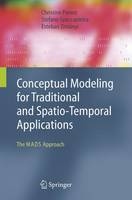


|
|
|
books
| book details |
Conceptual Modeling for Traditional and Spatio-Temporal Applications: The MADS Approach
By (author) Christine Parent, By (author) Stefano Spaccapietra, By (author) Esteban Zimányi

|
| on special |
normal price: R 4,539.95
Price: R 4,085.95
|
| book description |
From environmental management to land planning and geo-marketing, the number of application domains that may greatly benefit from using data enriched with spatio-temporal features is expanding very rapidly. Unfortunately, development of new spatio-temporal applications is hampered by the lack of conceptual design methods suited to cope with the additional complexity of spatio-temporal data. This complexity is obviously due to the particular semantics of space and time, but also to the need for multiple representations of the same reality to address the diversity of requirements from highly heterogeneous user communities. Conceptual design methods are also needed to facilitate the exchange and reuse of existing data sets, a must in geographical data management due to the high collection costs of the data. Yet, current practice in areas like geographical information systems or moving objects databases does not include conceptual design methods very well, if at all. This book shows that a conceptual design approach for spatio-temporal databases is both feasible and easy to apprehend. While providing a firm basis through extensive discussion of traditional data modeling concepts, the major focus of the book is on modeling spatial and temporal information. Parent, Spaccapietra and Zimányi provide a detailed and comprehensive description of an approach that fills the gap between application conceptual requirements and system capabilities, covering both data modeling and data manipulation features. The ideas presented summarize several years of research on the characteristics and description of space, time, and perception. In addition to the authors' own data modeling approach, MADS (Modeling of Application Data with Spatio-temporal features), the book also surveys alternative data models and approaches (from industry and academia) that target support of spatio-temporal modeling. The reader will acquire intimate knowledge of both thetraditional and innovative features that form a consistent data modeling approach. Visual notations and examples are employed extensively to illustrate the use of the various constructs. Therefore, this book is of major importance and interest to advanced professionals, researchers, and graduate or post-graduate students in the areas of spatio-temporal databases and geographical information systems. ""For anyone thinking of doing research in this field, or who is developing a system based on spatio-temporal data, this text is essential reading."" (Mike Worboys, U Maine, Orono, ME, USA) ""The high-level semantic model presented and validated in this book provides essential guidance to researchers and implementers when improving the capabilities of data systems to serve the actual needs of applications and their users in the temporal and spatial domains that are so prevalent today."" (Gio Wiederhold, Stanford U, CA, USA)
| product details |

Normally shipped |
Publisher | Springer-Verlag Berlin and Heidelberg GmbH & Co. KG
Published date | 20 Apr 2006
Language |
Format | Hardback
Pages | 466
Dimensions | 235 x 155 x 0mm (L x W x H)
Weight | 0g
ISBN | 978-3-5403-0153-0
Readership Age |
BISAC | computers / database management / general
| other options |

Normally shipped |
Readership Age |
Normal Price | R 4,627.95
Price | R 4,164.95
| on special |
|
|
|
To view the items in your trolley please sign in.
| sign in |
|
|
|
| specials |
|
Let's stare the future down and, instead of fearing AI, become solutionists.
|
|

|
Monde Ndandani
Paperback / softback
142 pages
was: R 220.95
now: R 198.95
|
|
|
|
|
|